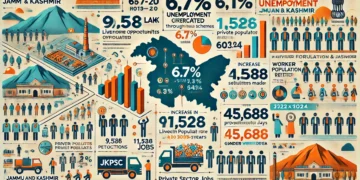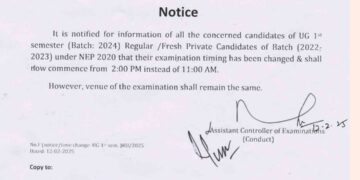Srinagar, April 14: According to the official document, Jammu and Kashmir would produce 28,000 metric tonnes of fish year 2023-24, with 19,530 metric tonnes already recorded by November 2024.
The region’s fisheries sector has seen a major increase in overall production in recent years, adding significantly to the local economy and job possibilities. Jammu & Kashmir’s total fish production reached 28,000 metric tonnes, up from 25,000 in 2022.
This expansion is part of a larger trend in the region’s fisheries sector, fuelled by novel technologies, government efforts, and strategic investment.The increase in production has been particularly noticeable in trout farming, with output rising from 598 metric tonnes in 2019 to 1,990 metric tonnes in the fiscal year 2022-23.
Overall, trout production has climbed by more than 300 percent over the last four years, from 650 metric tonnes in 2019 to 2,100 metric tonnes in 2023.Javid Ahmad Bhat of Tangmarg represents the success tales emanating from this sector.
After years in the hotel industry, the fisheries graduate wanted to use his knowledge of fish farming to improve his financial situation.I now hire two more professionals on my farm. I’ve always wanted to create my own farm.
“The money I earned while working in a hotel in Srinagar helped me start my farm,” Bhat explained. In just two years, his farm had produced over 20 quintals of rainbow trout.Currently, there are around 800 private trout fishing units in Kashmir.
Major fish-rich water bodies include Lidder, Wangath, Gurez, Hamal, Lam, Sindh, Kishenganga, Sukhnag, Doodhganga, Erin, Ferozpur (Tangmarg), Bringi, Aharbal, Hirpora, Dachigam, Kokernag, Naristan, Madhumati, and Nowbugh.
In addition to natural water bodies, the number of private fish farms in Kashmir has increased in recent years, with many entrepreneurs and farmers entering the business.
Numerous fisheries farms have been established with government help in the districts of Anantnag, Baramulla, Ganderbal, and Srinagar, strengthening the region’s fish farming business. Notably, Anantnag was designated the Trout Fish District of India in June 2018.The introduction of Recirculating Aquaculture System (RAS) and Biofloc technologies in 2020-21 has significantly improved fish production efficiency.
These methods optimise water and land use, making fish farming more sustainable and eco-friendly.The government has initiated a number of programs to enhance the fisheries sector, including the Pradhan Mantri Matsya Sampada Yojana (PMMSY), which seeks to increase fish production and improve post-harvest techniques.
The fisheries department is trying to make Jammu and Kashmir self-sufficient in fish production, with ambitious ambitions to boost growth rates from 3.28% to 40% over the next five years. This goal calls for expanding trout output to 4,000 metric tonnes and greatly increasing carp production.
Future plans seek to quadruple fish production by modernising hatcheries and implementing innovative aquaculture technologies. These activities are intended to boost productivity, enhance post-harvest management, and promote fisheries exports .
The total production of fish in Kashmir has increased by 5,840 metric tonnes, demonstrating substantial progress in this sector and its growing relevance to the regional economy.Rainbow trout, which was brought to Kashmir over 100 years ago, is now produced on a big scale in the region, with seeds also being given to other locations, further solidifying Kashmir’s status as an important centre for fish production in India.
Furthermore, the business has provided countless employment opportunities, notably among young people, with the establishment of 1,144 Trout Rearing Units, of which 611 units were set up in the last four years.
The government’s aim for self-sufficiency in food production and job creation has bolstered the industry,” an official stated.Wular Lake, one of Asia’s largest freshwater lakes, accounts for approximately 60% of Kashmir’s total fish catch. The lake’s fish productivity has consistently increased, with carp yield growing to 3,378.61 metric tonnes in 2023-24.
The department is assisting farmers in every way possible to ensure the success of their unit. Educated youth recognised the potential of this farming, and more than 1144 trout-rearing units have been developed in the private sector.










































